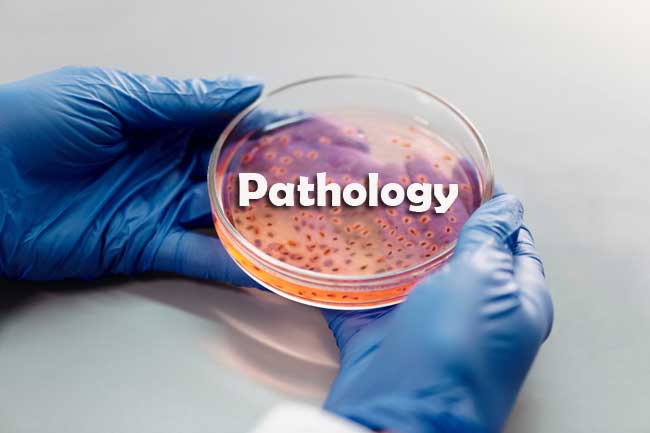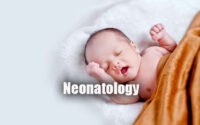Pathology Practice Question
Pathology Practice Question Papers Free Pdf is available. Download Pathology Practice Papers from the below attachments for free of cost. Pathology Practice Papers will definitely helpful for the aspirants to get an idea about the previously asked questions.

Here we provided Practice Question Papers of Pathology. Pathology Practice Papers is given below. The Aspirants who applied for the latest Pathology Recruitment for can check the Pathology Exam Practice Papers and Study Material in the sections below.
Practice Question on Pathology
1. The following tumour is characterised by biphasic pattern of growth :
(1) Osteosarcoma
(2) Osteochondroma
(3) Malignant fibrous histiocytoma
(4) Synovial sarcoma
2. In rheumatic fever fibrinoid necrosis occurs in
(1) Collagen
(2) Myocardium
(3) Pericardium
(4) Endocardium
3. Duodenal ulcers are found most commonly at
(1) First part, anterior surface
(2) First part, posterior surface
(3) Second part, anterior surface
(4) Second part, posterior surface
4. Barrett’s oesophagus predispose to development of
(1) Reflux oesophagitis
(2) Oesophageal varices
(3) Squamous cell carcinoma
(4) Adenocarcinoma
5. The following type of renal calculi are radiolucent
(1) Calcium phosphate
(2) Uric acid
(3) Magnesium ammonium phosphate
(4) Cystine
6. Lymphatic metastasis of Prostatic carcinoma occur initially to
(1) Obturator lymph node
(2) Perivesical lymph node
(3) Iliac lymph node
(4) Presacral lymph node
7. Krukenberg tumour is bilateral metastatic tumour from the following primary site, except :
(1) Colon
(2) Endometrium
(3) Ovary
(4) Stomach
8. Which is the most frequently altered oncogene in Pancreatic cancer ?
(1) K-ras
(2) RBI (13q)
(3) MKK4 (17p)
(4) MYB (6q)
9. Herring bone pattern seen in
(1) Fibrosarcoma
(2) Letomyoma
(3) Osteoma
(4) Osteosarcoma
10. Bullous lesion of the skin is
(1) Lichen Planus
(2) Seborrhoeic dermatitis
(3) Pemphigus Vulgaris
(4) Psoriasis
11. Antoni A and Antoni B growth pattern seen in
(1) Schwannoma
(2) Neurofibroma
(3) Meningioma
(4) Ganglioma
12. Most common cyst arising from Dental tissue is
(1) Dermoid Cyst
(2) Radicular Cyst
(3) Gingival Cyst
(4) Eruption Cyst
13. The pseudocartilage in mixed salivary tumour is a product of
(1) Connective tissue mucin
(2) Ductal epithelial cell origin
(3) Myoepithelial cell origin
(4) Combination of all mucin
14. Serum marker for Rapidly Progressive Glomerulonephritis (RPGN) type III is
(1) C3
(2) Anti-Nutrophil Cytoplasmic antibody (ANCA)
(3) Anti GBM Antibody
(4) Good pasture antigen
15. Starry sky pattern is characteristic of
(1) Follicular lymphoma
(2) Small lymphocytic lymphoma
(3) Hodgkin’s lymphoma
(4) Burkitt lymphoma
16. The first event in the pathogenesis of cholesterol stones is
(1) Infection
(2) Bile Stasis
(3) Mucus secretion in the lumen
(4) Supersaturation of bile with cholesterol
17. Pseudo rosette seen in all, except :
(1) Neuroblastoma
(2) Neurocysticercosis
(3) Retinoblastoma
(4) Medulloblastoma
18. Nesidioblastosis is due to hyperplasia of
(1) Alpha Cells
(2) Acinus
(3) Beta Cells
(4) D-Cells
19. In Pheochromocytoma Malignancy is indicated by
(1) Metastases
(2) Mitotic figures
(3) Capsular invasion
(4) Vascular invasion
20. Wermer Syndrome is
(1) MEN type 2A
(2) MEN type
(3) MEN type 2B
(4) Von Hippel – Lindau
| Mock Test | Practice Set |
| Important Questions | Quiz |
| Sample Papers | MCQ |
| Model Question | Questions and Answers |
21. Schiller-Duval body seen in
(1) Endodermal sinus tumour
(2) Dysgerminoma
(3) Choriocarcinoma
(4) Granulosa theca cell tumour
22. Anaemia with reticulocytosis is seen in
(1) Haemolysis
(2) Iron deficiency anaemia
(3) Vit. B12 deficiency
(4) Aplastic anaemia
23. In hereditary spherocytosis, the following membrane structure is deficient :
(1) Band 3 protein
(2) Glycophorin
(3) Spectrin
(4) Glycolipid
24. Intracorpuscular haemolytic anaemia is seen in
(1) Thalassaemia
(2) Auto immune haemolytic anaemia (AIHA)
(3) Idiopathic Thrombocytopinic Purpura (ITP)
(4) Infection
25. Bone marrow finding in Myclofibrosis is
(1) Dry tap (Hypocellular)
(2) Megaloblastic
(3) Microcytic cells
(4) Thrombocytosis
26. Deletion of all four normal α-globin genes will most likely produce
(1) α-Thalassaemia
(2) β-Thalassaemia
(3) Haemoglobin H disease
(4) Hydrops fetalis
27. Neutrophil secretes
(1) Lysosomal enzyme
(2) Catalase
(3) Superoxide dismutase
(4) Cathepsin
28. Paroxysmal nocturnal Haemoglobinuria (PNH) due to defect in
(1) CD59
(2) CD15
(3) CD 100
(4) CD20
29. Iron is absorbed from enterocytes through which of the following ?
(1) Divalent metal transporter (DMT 1)
(2) Hephaestin
(3) Ferroportin
(4) Transferrin
30. All are Vitamin K dependent factors, except :
(1) Factor Il
(2) Factor VI
(3) Factor VI
(4) Factor IX
31. Which is NOT True of Bombay Blood group ?
(1) Lack of A, B, H antigen on erythrocyte.
(2) Can donate red blood cells to any member of ABO blood group.
(3) They cannot receive blood from A, B or O group donor.
(4) Express ‘H’ antigen on erythrocyte.
32. Holly — leaf shape RBC seen in
(1) Sickle cell anaemia
(2) Microangiopathic haemolytic anaemia
(3) Thalassaemia
(4) Anaemia of chronic disorder
33. Porphyria result from the abnormal synthesis of
(1) α-Globin
(2) β-Globin
(3) Spectrin
(4) Heme
34. Antibodies in Idiopathic Thromocytopacnic purpura (ITP) are
(1) IgG
(2) IgM
(3) IgE
(4) IgA
35. The earliest haematologic evidence of response to treatment in from Deficiency anaemia is
(1) Reticulocytosis
(2) The red cell indices
(3) Increase in Iron binding capacity
(4) Increase in haemoglobin
36. Chromosome for Rh :
(1) 9
(2) 13
(3) 19
(4) 1
37. Blood stored at what temperature in Blood Bank ”?
(1) 2 to 6 degree Celsius
(2) 6 to 8 degree Celsius
(3) -2 to -6 degree Celsius
(4) 6 to 12 degree Celsius
38. Complications of Massive Blood transfusion is
(1) Hyperthermia
(2) Hypercalcaemia
(3) Hyperfibrinogenaemia
(4) Hyperkalaemia
39. Thalassaemia gives protection against
(1) Filaria
(2) Kala-azar
(3) Malaria
(4) None of these
40. Blood Transfusion reactions are
(1) Type I Hypersensitivity
(2) Type II Hypersensitivity
(3) Type III Hypersensitivity
(4) Type IV Hypersensitivity
41. Under Blood Safety Programme, compulsory Tests are done all, except :
(1) HIV
(2) Malaria
(3) Hepatitis E
(4) Hepatitis C
42. Test for factor VIII deficiency identification is
(1) PT
(2) APTT
(3) Ddimer
(4) FDP
43. Cryoprecipitate is rich in
(1) Protein
(2) Factor VIII
(3) Factor VI
(4) Factor X
44. Platelet stored at what temperature in Blood Bank ?
(1) 22 to 24 degree Celsius
(2) 6 to 12 degree Celsius
(3) 1 to 6 degree Celsius
(4) 30 to 37 degree Celsius
45. Severe deficiency of coagulation Factor IX produce disorder
(1) Haemophilia A
(2) Haemophilia B
(3) Von Willebrand’s disease type I
(4) Von Willebrand’s disease type II



